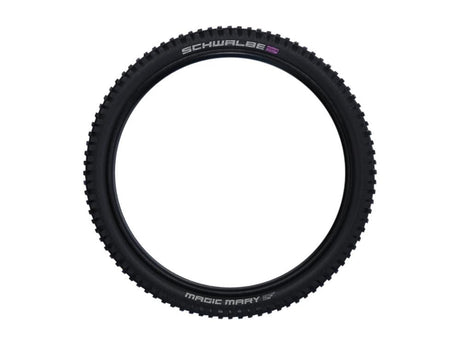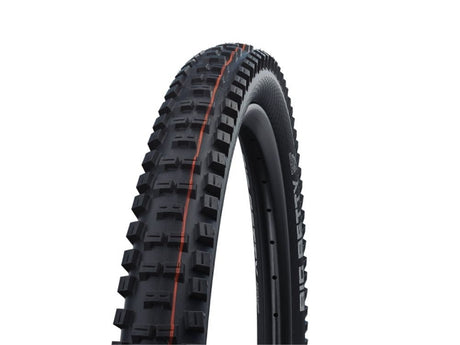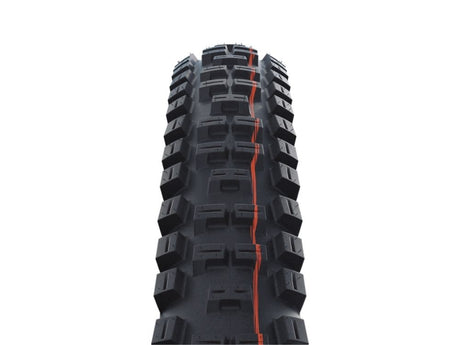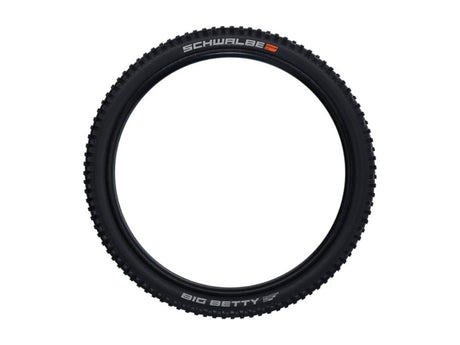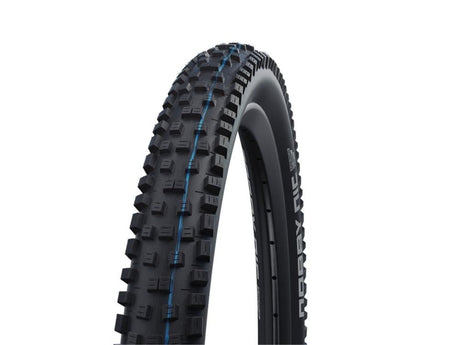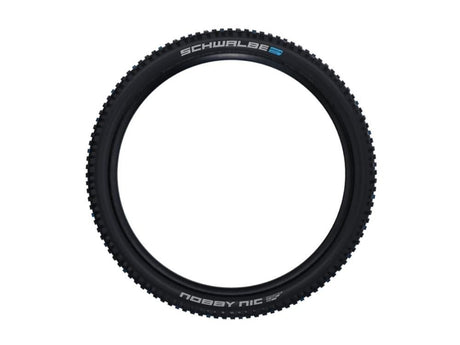Watch the video or read the blog to learn all about Schwalbe Tires!
With riding disciplines becoming more and more specified, the need for more and more specified components is also rising. These niche components go beyond stanchion diameter and cogs on a cassette, they also extend to tires. Rocky, rough trails require a burlier tire to prevent flats and rim damage, and aggressive riders are looking for the utmost grip in loose conditions. Cross country racers, on the other hand, need something light that rolls extremely well for maximum efficiency.
These disciplines, and many others in between, have very different demands for a tire and Schwalbe does an excellent job at making sure the niches are filled. We’ll be looking at their entire range of casing construction and rubber compounds, with more of a focus on their trail, enduro, and downhill options. We’ll also sit down with our mechanic guru Russ to talk about tread patterns and how to pair them together nicely for the conditions and types of trails you’re riding on. But no matter what kind of tire you’re looking for, Schwalbe has great options for every riding application you can think of.
Intro
There’s two variables in each model of tire that Schwalbe makes - The casing and rubber compound.
The same model of tire can come in a wide variety of combinations of the two, and each can feel completely different out on the trail.
The casing of a tire wraps around the whole structure of the tire and plays a huge part in cornering support, puncture resistance, rolling resistance, and even acts as a part of your suspension. The rubber compound is the rubber that your knobs are made out of. This will determine your grip as well as your rolling resistance.
With five different casings, and four different rubber compounds, how do you decide which is best for you? Unfortunately, there’s no one tire to rule them all, and that’s exactly why they come in so many options. It depends entirely on what you’re looking for in a tire to tackle the terrain you like to ride, so let’s look at what you can expect from each of your options.
Schwalbe Tires Sidewall Casings
First, let’s look at all of the casing options.
Ranging from cross country to downhill, the Schwalbe casings are Super Race, Super Ground, Super Trail, Super Gravity, and Super Downhill. Holy crap that’s a lot of supers! These casings basically refer to how thick and burly a casing is, and change the weight and overall riding characteristics of the tire.
Super Race and Super Ground
Starting with their lightest weight casings we have their Super Race and Super Ground casings, which are made primarily for cross country bikes. You can think of both of these being pretty similar to a Maxxis Exo casing, but we currently don’t carry either of these here at The Lost Co. We’re a bit more gravity focused, so let’s get to the casings you’ll want to run on your trail bike, enduro bike, or downhill bike.
Super Trail
The first one we’ll be taking a look at is their Super Trail casing. This is one of their most widely applicable casings that is right at home on almost any bike. It’s made up of three main carcass layers, their Snake Skin layer, and on top of that, their Apex layer. All of these come together in holy matrimony to strike a balance between a reasonable weight and great performance, and is super comparable to a Maxxis EXO+ casing. The Super Trail casing is a great option for a front or rear tire on just about any trail bike, but some people may want something a bit more burly in the rear, so let’s introduce you to my friends, the Super Gravity and Super Downhill casings.
Super Gravity
Now we’re getting to some of their properly thick casings, and first up is the Super Gravity. This casing has an added carcass layer over the Super Trail, making it 4 carcass layers with the Snake Skin and Apex layers for extra protection. This casing is ready for action, and is super popular on Enduro bikes. It feels pretty similar to a Double Down from Maxxis, so if you like that casing, you’ll like this casing! You may have seen this casing in the video about building up my Spire and this is one of my favorite tire casings on the market. It’s got plenty of support to hold up when ripping into berms and the weight isn’t overbearing on those long climbs.
Super Downhill
For those of you looking for the absolute strongest casing that Schwalbe makes, then you’re looking for the Super Downhill casing. This stuff is the onions of tire casings, with more layers than I can even count. It’s got 6 carcass layers, doubles up on the Apex protection, and has the snakeskin layer as well. Yeah it’s pretty heavy but who cares if you’re taking a chairlift to the top! And you can almost forget about flat tires when you’ve got this much thickness around your rim. That’s why these are super popular for enduro and downhill racers where a flat tire can ruin their entire weekend. If you’re planning on doing a big 50 mile ride, then these probably aren’t going to be your first choice.
Schwalbe Tire Rubber Compounds
Now we have the rubber compounds, which wrap around all of those tire casings. Schwalbe has a lineup of four different compounds in their Addix range. Much like casings, these are all very different and perform very different jobs, and each one has its place. The main factors that the rubber compound influences are grip, rolling speed, and durability.
As a rule of thumb, the softer the rubber compound, you’ll gain grip but lose rolling speed and durability.
As the stiffer the rubber compound, you’ll gain durability and rolling speed but you will lose some of that precious grip.
Addix Speed and SpeedGrip
We’ll start with the stiffest rubbers, and those are the Addix Speed with the red stripe and Addix SpeedGrip with the blue stripe. They’re not hiding anything with those names, and they’re built for all out speed. If you’re trying to hit 88 MPH and go back to the future then these are built for you. Both of these are super popular on XC bikes where maximum rolling speed is the name of the game and grip isn’t the main focus. None of the tire models we carry here come in either of these compounds because they’re not really ideal for aggressive trail riding where gravity’s supplying your speed and you’re looking for maximum contact with the earth. So let’s check out their stickier compounds.
Addix Soft
We’ll start with the Addix Soft. They’re pretty straight shooters with their naming conventions, and this is some seriously soft rubber. This is what I’ve been running and racing on my bike and I’ve been a huge fan of it. It’s plenty sticky enough to keep you attached to the trail but also lasts long enough that your tires are fresh for plenty of rides. You can tell if a tire has the Addix Soft compound if it has the orange stripe along the tread.
Addix UltraSoft
If the Addix Soft just isn’t soft enough for you, then the Charmin UltraSoft, I mean Addix UltraSoft is what you’re looking for. This is Schwabe’s softest rubber compound and really is crazy sticky. This will basically let you ride upside down, but will also wear out the fastest of any of their tire compounds. It also has the most rolling resistance of all the options, so this will be best suited for the steepest trails you can find, where gravity does all the work of pulling you down the hill. Most downhill racers on Schwalbe tires will run this compound as they’re more concerned about hooking up in blown out corners than conserving energy.
Tire Tread Patterns
And now the final piece of the puzzle, we have the actual tread patterns of the tires! We’ll take a look at our four favorite models Schwalbe offers, which are the Magic Mary, Big Betty, Nobby Nic, and Dirty Dan. Dang they’re really leaning into that alliteration! With these four tires, you’ve got a great tread for any condition, ranging from dusty hardpack summer to brutal muddy conditions.
Schwalbe Nobby Nic
The Nobby Nic is going to be the fastest rolling option of the three, and also the most versatile. This tire is at home on just about any bike, from a short travel down country rig, all the way up to a long travel enduro machine. With great coverage and lots of knobs, this tire is super predictable in dry and hardpack conditions, and is a great tire for riders of all skill levels. All of the knobs also have little slits in them which lets them conform to the terrain a bit more than if they were solid without costing too much efficiency in rolling resistance. Those knobs aren’t the tallest, so they’ll struggle when the dirt gets soft, loose, or wet.
Schwalbe Magic Mary
Check out the full Mary review!
When the dirt gets soft, loose, or wet - that’s where something like the Magic Mary comes into play. The knob layout is actually fairly similar to the Nobby Nic but with way beefier knobs. The steeper the trail, the better the Magic Mary will perform because it does have a fair amount of rolling resistance to overcome. This makes it super popular for people riding steep and loose terrain where you can take advantage of those big ol’ side knobs digging in and you have gravity throwing you down the hill. With its wider spacing between those tall knobs, the Magic Mary is more than happy to tackle wet conditions, and is one of our favorite all season tires because of its impressive grip in both the dry and the wet.
Schwalbe Dirty Dan
If your trails look more like a sloppy pig pen than a hard packed flow trail, then the Dirty Dan is going to be your savior. This tire is built for the mud, with the longest knobs of any Schwalbe tire. This thing is a beast in the right conditions, and can turn an almost unrideable slop fest into another super fun bike ride. You won’t want to run these tires on a hard pack surface, even in the wet, because the knobs are so long that they get squirmy and won’t offer any support when they’re all folded over.
Schwalbe Big Betty
Last but not least, we have the Big Betty. This tire is the only one of the three that prioritizes braking traction and is most at home on the rear. With these wider knobs, they’re going to act like big old anchors to slow you down. Not only are they wide, but they’re also tall, so they’ll bite into that loose dirt like a tractor tilling the earth. It’s also got some seriously supportive side knobs so you can really trust it when you lean it over, but it can be a bit vague in between the braking knobs in the middle and cornering knobs on the side. That’s why it’s better suited for the rear tire. Your front getting drifty while you lean it over is just about the last thing we’re looking for!
Putting It All Together
Alright, now that we’ve got all the puzzle pieces laid out on the table, let’s start putting the picture together. Obviously, your bike has two tires, but it’s a little less obvious that they perform very different tasks. A casing/compound/tread combo for a front tire might not make sense for the rear, and vice versa.
General Rules Of Thumb
Your rear tire is going to be taking more of a beating out on the trail so it’s common to go for a more supportive casing just to avoid flats and give yourself a bit more support in the corners. The front tire typically doesn’t get the same abuse, so you can get away with running a slightly lighter casing and save a bit of weight on the front end, which is always a positive.
As for rubber compounds, we’ll typically recommend running a softer compound on the front than the back. This is for a couple of reasons, first being that you don’t want your front tire to start losing traction before the rear. That’s one of the scariest feelings on two wheels, and a softer front tire is a good way to keep it from happening. Also, as much as we try to avoid it, you’re going to be skidding more on the rear than the front, so that soft compound will last a lot longer than if it was in the rear.
Which Schwalbe Casing And Compound Is Best For You?
As for which rubber compounds and sidewall casings and tread patterns are right for you, there are a lot of right answers! From the weather conditions to the type of trails you ride, everything is a factor.
Here in the Pacific Northwest, we have a very dry summer and a very wet winter, and my tire choice changes depending on the season. During the grippier summer months, you could run a firmer rubber set up, with the Addix Soft compound in the front and Addix SpeedGrip in the rear. When the rain starts coming down every day and the trails get a bit softer, you could switch it up and run an Addix Soft in the rear with the Addix UltraSoft in the front. When speeds are lower and the dirt is softer, these softer compounds will last quite a bit longer and bite into that soft dirt a little better.
But no matter what season it is, I’ll always run at least a Super Trail casing in the front and a Super Gravity casing in the rear. I find that the casing is less condition dependent than the rubber compound, and is much more dependent on the types of trails that you're riding.
The only way to figure out what works best for you is to just try different casings out! Mix it up when you buy your next tires and you may be surprised that you can get away with running lighter tires than you thought or you could be impressed with how your bike handles with slightly thicker casings! When running a lighter casing tire, it’s a good idea to run a few more psi than before to help the thinner casing keep its shape a bit better.
Which Casing And Compound Is Best For What Bike?
As for which casing and rubber compound belongs on which bike, there really aren’t any rules you have to follow, and it all depends on what kind of terrain you’re riding and how much performance you want from your tires. If you’re someone who’s ripping into corners and burping air, then you should be going for a thicker casing tire just to keep everything under control. Or if you’re someone who’s out there for fitness or exploration and not riding the most technically challenging trails at breakneck speed then you’ll be able to save some weight and get some lighter casings. That being said, no matter what your setup is, we recommend a heavier duty casing in the rear to take the hits and a lighter casing in the front just to save some weight.
If you’re going to be riding a bike park, it could be a good idea to throw on a thicker casing tire than you’re used to because it’ll be taking quite a bit more abuse than usual riding fast and often blown out trails. Also you won’t have to worry about lugging that heavier tire up the climbs when you’ve got the luxury of the chair lift ride up.


